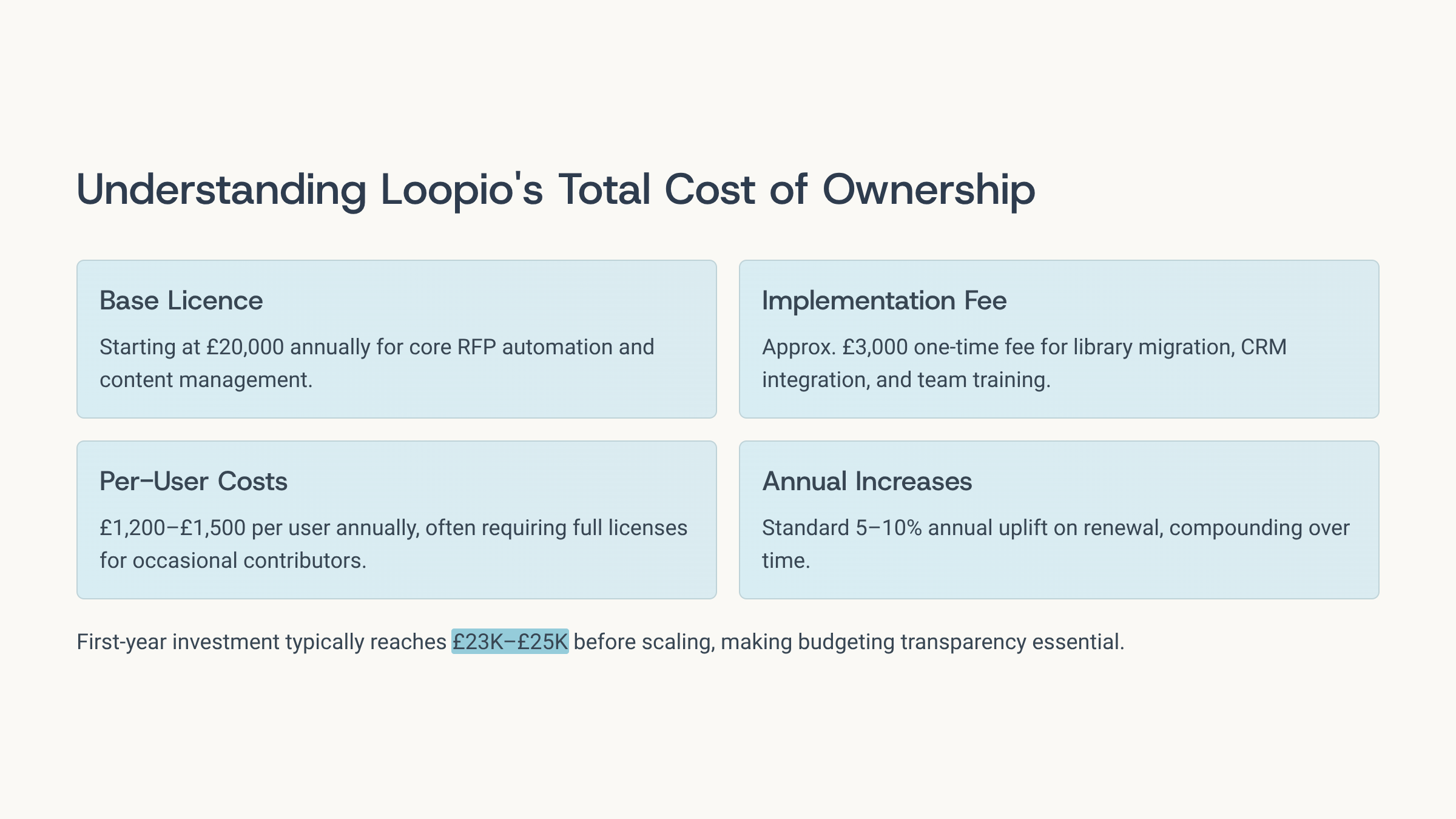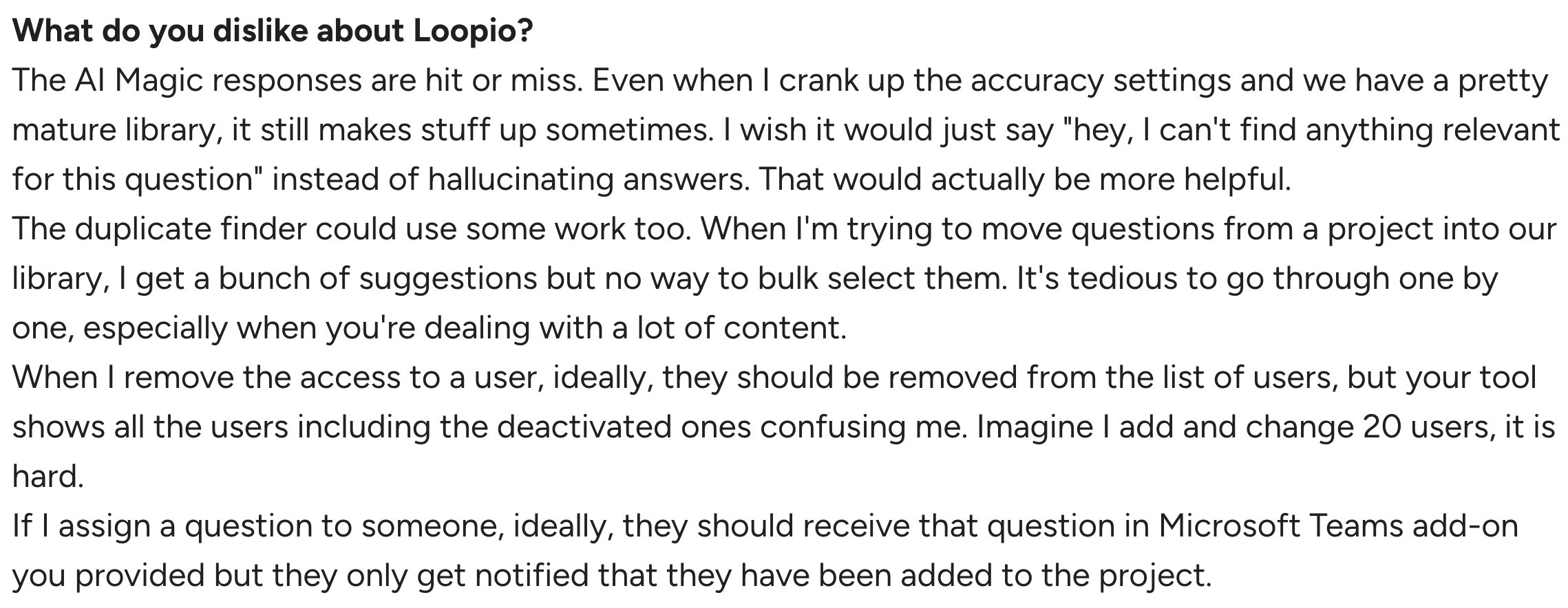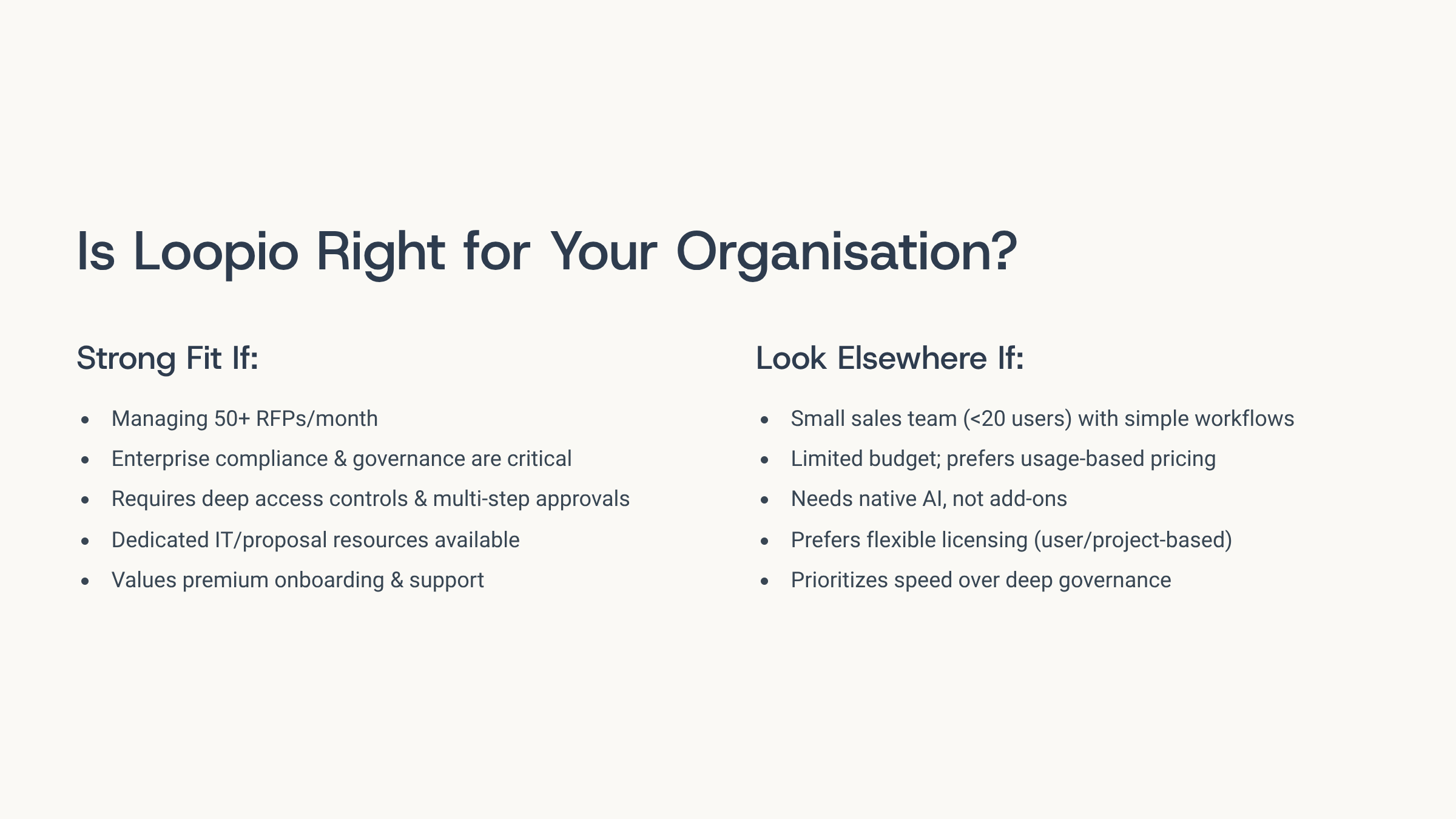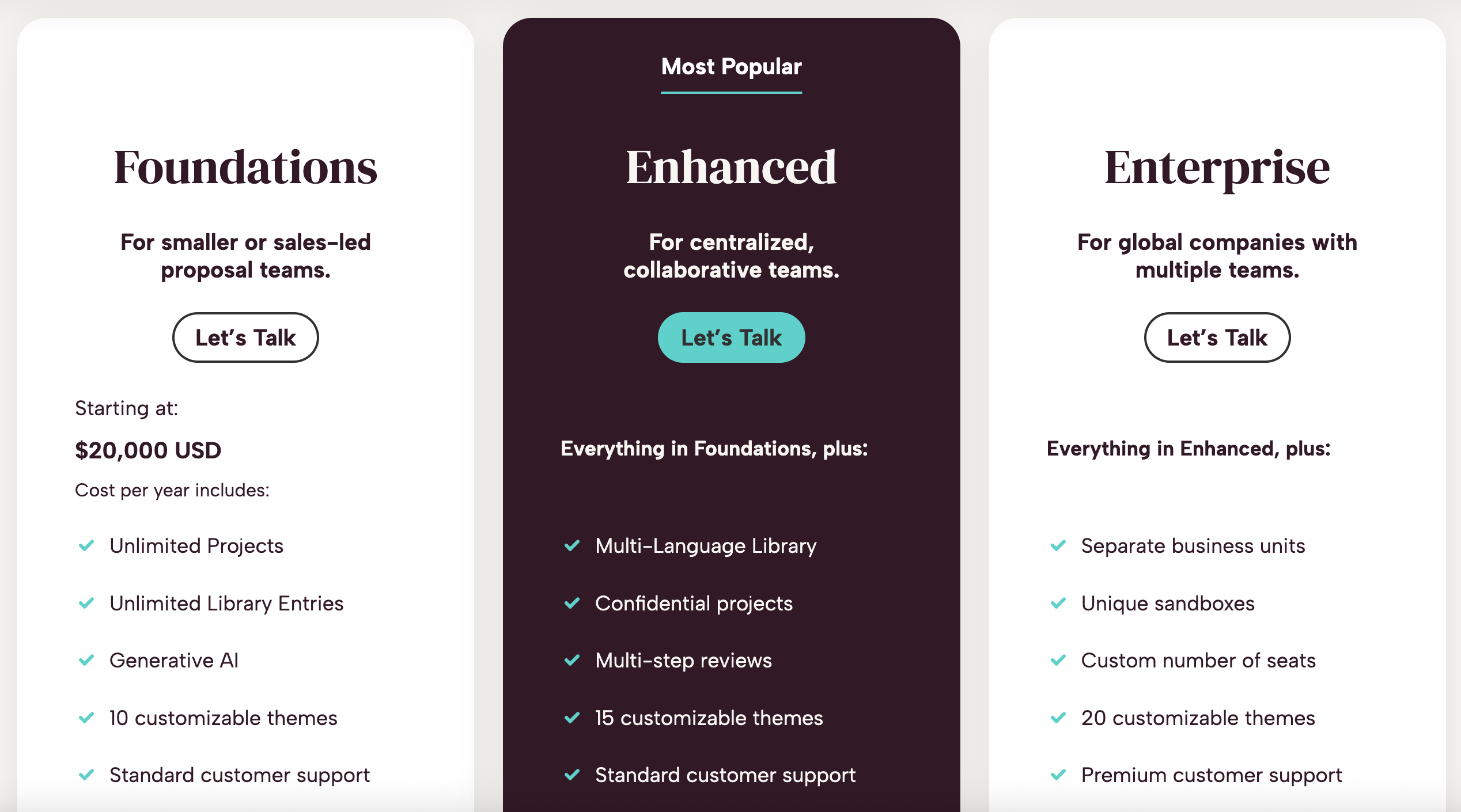Loopio Pricing (2026): What You'll Actually Pay and Whether It's Worth It
Article written by
Vipin Thomas

INSIDE THE ARTICLE
SHARE THIS ARTICLE
Summary
Loopio delivers enterprise-grade governance and collaboration—but at a premium. Starting around $20K annually, it suits high-volume, compliance-focused teams. This breakdown reveals Loopio’s true total cost, ROI benchmarks, and how AI-native RFP tools are reshaping the cost-to-value equation.
Loopio has long been the enterprise standard for RFP automation. With costs starting at $20K+ per year and climbing, many teams are asking: does the value still justify the spend?
This analysis breaks down Loopio's actual total cost of ownership, examines what drives those expenses, and helps you determine whether it aligns with your team's scale and workflow
What Is Loopio and Why Does It Cost So Much?
Loopio is an RFP response and proposal automation platform built for large enterprises that manage dozens, or even hundreds, of RFPs each year across multiple business units. It helps teams centralize and standardize proposal workflows that would otherwise be chaotic and manual.
What Problems Does Loopio Solve in RFP Management?
In most enterprise environments, RFP workflows involve multiple approvers, fragmented content sources, and strict compliance reviews. Without centralization:
- Proposal sections get duplicated across projects.
- Section-level approvals stall mid-cycle.
- Version control becomes a nightmare of long email chains.
- Field-level redlines disappear between reviews.
Loopio eliminates that chaos by consolidating everything into one secure workspace for content, collaboration, and compliance.
Why Is Loopio So Expensive Compared to Other RFP Tools?
Loopio’s higher price reflects three core enterprise-grade investments that define its value:
- Enterprise Compliance Infrastructure Loopio includes section-level approval workflows, field-level redline tracking, library de-duplication, review SLAs, and audit logs, features designed for regulated industries like healthcare, finance, and government contracting.
- Dedicated Support Model Every Loopio plan comes with success managers, structured training, and ongoing optimization, justifying its higher per-seat costs compared to self-serve RFP automation software.
- Legacy Product Maturity Built before the rise of AI-native proposal tools, Loopio’s architecture requires additional integration, migration, and onboarding effort—costs that are often built into its implementation and licensing fees.
Loopio’s pricing reflects its enterprise-grade governance and support. That’s ideal for organizations with complex approval chains and compliance needs, but less practical for lean sales teams that prioritize speed, flexibility, and AI-driven automation.
Loopio Pricing Summary (2026)
Metric | Figure |
Starting annual price | $20,000 USD |
One-time setup fee | ~$3,000 |
Typical per-user cost range | $1,200–1,500/year* |
Annual renewal increase | 5–10% |
Typical first-year total | $23K–$25K |
*Typical range reported by buyers; actual quotes vary based on user count, contract term, and quarter-end timing.
Loopio Pricing Tiers Explained
Loopio uses a quote-based model with three primary tiers:
Plan | Primary Use Case | Key Features | Starting Price |
Foundations | Smaller or sales-led teams | Unlimited projects, unlimited library entries, Generative AI, 10 customizable themes, standard support | $20,000/year |
Enhanced | Centralized, collaborative teams | Everything in Foundations + Multi-language library, confidential projects, multi-step reviews, 15 themes | Custom quote |
Enterprise | Global organizations, multiple units | Everything in Enhanced + Separate business units, sandboxes, custom seat counts, 20 themes, premium support | Custom quote |
Takeaway: Even "basic" Foundations teams ($20K) are paying $2,000–$2,500 per user annually, a commitment that scales quickly as headcount grows.
Loopio Implementation Costs: What You’ll Pay in Year One
When evaluating Loopio pricing, it’s important to factor in not just the base license but also the implementation and setup costs that come with onboarding.
New Loopio customers typically pay a one-time implementation fee of around $3,000, which covers:
- Library migration: Transferring existing proposal templates, boilerplates, and content into Loopio’s library system.
- Salesforce/CRM integration setup: Connecting Loopio to your existing sales or CRM stack for seamless RFP tracking.
- Team onboarding and training: Equipping users with the skills to manage workflows, approvals, and content effectively.
For larger enterprises with extensive content repositories or complex integrations, implementation costs can exceed $3,000. This setup overhead is a major reason why Loopio’s total first-year investment often lands in the $23K–$25K range, even for smaller teams.

First-Year Cost Snapshot:
- Base license (Foundations): $20,000
- Implementation & setup: ~$3,000
- Typical first-year total: $23K–$25K
- Year two and beyond: Add 5–10% annually
Takeaway: While Loopio’s upfront cost can feel steep, it reflects the platform’s enterprise onboarding model, combining migration support, training, and CRM integration into a structured rollout.
Loopio Total Cost of Ownership
Based on procurement data and verified buyer quotes, here's what organizations typically report:
Organization Size | Annual Cost | Notes |
5–10 users | $20–25K | Foundations plan + standard onboarding |
10–20 users | $25–35K | Enhanced plan + multi-language library and review workflows |
50+ users | $50–100K+ | Multiple business units, sandboxes, premium support, custom integrations |
Takeaway: Even small teams (5–10 users) often cross the $25K threshold once implementation costs are factored in. Mid-market organizations (10–20 users) typically budget $30K–$35K for year one.
Planning for growth: Most buyers upgrade to Enhanced or Enterprise within 12–18 months as RFP volume increases. Factor this trajectory into budget planning.
Loopio Add-Ons and Pricing Variables That Increase Your Spend
Loopio's base subscription covers core RFP automation and content management. However, several capabilities that teams frequently require are priced separately or bundled in higher tiers:
Capability | Typical Cost | What It Covers | When You Might Need It |
Salesforce/CRM integration | $2,000–3,000 | API connectivity and bi-directional syncing | If your pipeline lives in Salesforce or HubSpot |
Single Sign-On (SSO) | $1,000–2,000 | Enterprise authentication via Okta, Azure AD | Required for most enterprise IT policies |
Go/No-Go workflows | $1,500–3,000 | RFP qualification and approval gates | If you need to filter low-probability deals before investing effort |
Premium success manager | ~$3,500 | Dedicated account support and optimization | For teams seeking white-glove onboarding |
Multi-language/region libraries | Variable | Content localization and regional compliance | Global organizations or international bid teams |

Procurement Strategy
Buyers report negotiating add-ons during initial contract discussions can reduce total cost by 25–40%, depending on term length and user count. Bundle feature requests upfront rather than adopting incrementally; pricing flexibility tends to correlate with contract commitment.
Loopio Customer Reviews: What Real Users Say About Cost and Value
According to 200+ verified G2 reviews and multiple procurement interviews, Loopio earns consistently high marks for its reliability, collaboration tools, and governance features. However, when it comes to Loopio pricing, cost remains a common point of discussion among users.
What Customers Are Saying
Even premium tools have their pain points, and Loopio’s customer feedback on G2 reflects that. Even when you’re paying a premium expecting the best, real user reviews tell a different story, some customers aren’t entirely happy with Loopio’s performance. It’s a good reminder to do your homework before choosing any tool. Here are a few verified reviews from G2:
1. Pricing & Customization
“For smaller teams, Loopio feels expensive. The customization options are limited, and the learning curve can be steep.”

2. AI Accuracy & Workflow Issues
“The AI Magic is hit or miss. Duplicate finder needs work, and the user access system can get confusing.”

3. Library & Usability Gaps
“Loopio often misses relevant answers. Uploading one file at a time slows us down, and some tabs never load correctly.”

Where Loopio Excels (and Where It Struggles)
Where Loopio Excels
Loopio stands out as one of the most mature and trusted RFP automation platforms on the market, especially for large enterprises with complex compliance needs.
1. Mature, Proven Platform
Trusted by Fortune 500 companies across regulated industries, Loopio has built a solid reputation for reliability, scalability, and long-term stability.
2. Governance & Compliance Infrastructure
Enterprise-ready role-based access controls, detailed audit trails, and comprehensive version history help organizations meet strict security and compliance requirements.
3. Deep Collaboration Capabilities
Multi-step reviews, structured approval workflows, and powerful library management make it easier for large cross-functional teams to collaborate on high-value RFPs.
4. Dedicated Support Model
A hands-on success team and robust training infrastructure ensure continuous optimization, keeping processes aligned as organizations scale.
Where Loopio Faces Limitations
While Loopio’s feature depth is impressive, several cost-related challenges limit its flexibility—especially for mid-market and fast-growing teams evaluating Loopio pricing.
1. Seat-Based Pricing Inflexibility
Organizations must pay for full licenses even for occasional contributors, making scalability expensive and reducing cost-efficiency.
2. Add-On Cost Escalation
Essential capabilities like SSO, CRM integrations, and workflow automation are often priced separately, pushing the total cost of ownership well beyond initial quotes.
3. Implementation Overhead
Content migration and setup require dedicated time and IT resources, which can delay ROI for mid-market buyers evaluating 12–24 month payback cycles.
4. AI Integration Approach
Loopio’s AI capabilities are still evolving and primarily offered as add-ons rather than being natively embedded across all core workflows.
Overall Sentiment
Overall, Loopio reviews highlight a strong, stable platform that excels in enterprise governance and collaboration infrastructure.
The main drawback? Price sensitivity.
Mid-market organizations and teams with fewer than 20 active users often report that Loopio’s cost structure feels restrictive. In contrast, enterprise buyers managing 50+ RFPs annually and operating across multiple business units express satisfaction with Loopio’s ROI, citing measurable efficiency gains and improved compliance visibility.
Loopio vs Other RFP Automation Tools: How It Compares in 2026
Loopio's positioning depends on organizational scale and workflow philosophy. Here's how it stacks against other established and emerging solutions:
Dimension | Loopio | Responsive (RFPIO) | AutoRFP.ai | SparrowGenie |
Pricing model | Seat-based (annual) | Seat-based/tiered | Usage-based | Hybrid (user or project-based) |
AI capabilities | Generative AI (add-on) | AI assist for responses | Native GenAI throughout | AI-powered RFP + proposal creation |
Collaboration scope | Role-based teams | Large teams / sales ops | Unlimited users | Cross-team sales enablement |
Implementation | High-touch; time: 3–4 weeks | Moderate setup; time: 2–3 weeks | Self-serve; time: 1 week | Guided; time: 1–2 weeks |
Typical buyer profile | Enterprise RFP governance across units | Mid-to-large organizations | Cost-conscious buyers with simpler needs | Sales-led organizations; flexibility priority |
Key differentiation: Loopio's value concentrates on governance, audit, and compliance for organizations with multi-unit RFP operations and regulatory requirements. Alternative platforms vary in pricing model, AI depth, and implementation approach.
Who Should Choose Loopio and Who Should Avoid It
Loopio isn’t a one-size-fits-all RFP automation platform. Its pricing, governance capabilities, and implementation model make it ideal for large organizations but less practical for lean, high-velocity sales teams.
Loopio Is a Strong Fit If:
You’ll get the most value from Loopio if your organization meets most of these criteria:
- You manage 50+ RFPs monthly across multiple business units or regions.
- Enterprise-grade compliance and governance are non-negotiable.
- Your team requires deep role-based access controls and multi-step approval workflows.
- You have dedicated IT or proposal operations resources to manage integrations and library migration.
- Your organization values white-glove onboarding, premium support, and structured implementation.
Look Elsewhere If:
Loopio may not be the best fit if your team prioritizes agility, speed, and predictable pricing. Consider alternatives if:
- You’re a smaller sales team (under 20 users) with straightforward proposal workflows.
- Your budget is limited, and you prefer transparent, usage-based pricing.
- You need native AI capabilities embedded across your RFP workflows, not as paid add-ons.
- You want flexible licensing models (user- or project-based billing).
- You operate in a fast-moving sales environment where turnaround time matters more than governance depth.

Loopio’s structured environment and robust compliance features make it a great fit for enterprise RFP teams that prioritize governance and scalability over flexibility. But if you’re a growth-stage SaaS company or agile sales organization, explore AI-native alternatives like SparrowGenie that offer faster onboarding, flexible pricing, and automation-first workflows.
How Much Loopio Costs in 2026: Final Pricing Breakdown
Loopio's pricing starts at $20,000 USD annually for the Foundations tier, with a one-time implementation fee of approximately $3,000. Most organizations report first-year investments of $23K–$25K. The actual cost depends on team size, contract term, and add-ons negotiated.

Source: Loopio
See the pricing breakdown above and FAQ section below for specifics tailored to different organization sizes.
Is Loopio Worth the Price for Enterprise RFP Teams?
Short answer: Yes, but only if you’re a large enterprise managing 50+ RFPs annually and operating under strict compliance or audit requirements.
Loopio’s $20K+ annual cost and seat-based pricing model make sense for organizations that:
- Manage multiple business units or regions,
- Require audit-grade governance, and
- Have the budget for white-glove onboarding and dedicated success management.
For these teams, Loopio’s robust governance framework, compliance controls, and support infrastructure deliver measurable ROI, improving RFP consistency, collaboration, and accountability across departments.
However, if you’re a smaller or mid-market sales team with fewer than 20 users, or if you operate in a fast-moving, budget-conscious environment, Loopio’s total cost of ownership may feel heavy.
Modern AI-native RFP automation tools now offer flexible, usage-based pricing and faster implementations, allowing leaner teams to achieve similar outcomes without the enterprise overhead.
Loopio’s value holds up for large, complex proposal operations, but before committing, evaluate your:
- RFP volume: Are you handling 50+ projects per year?
- Governance complexity: Do you truly need deep compliance infrastructure?
- Budget trajectory: Can you sustain 5–10% annual uplifts?
If the answer to most of these is “yes,” Loopio is worth the investment. If not, consider AI-driven alternatives like SparrowGenie for faster, flexible, and cost-efficient proposal management.
Final Perspective
Loopio remains one of the top-tier enterprise solutions for managing complex, high-volume RFP workflows across multiple business units. Its strong governance controls, compliance infrastructure, and dedicated support model consistently deliver measurable ROI for large organizations with mature proposal operations.
However, the $20K+ annual entry point and seat-based licensing model place Loopio firmly in the enterprise bracket—making it less accessible to mid-market or smaller teams with limited budgets or faster-moving sales cycles.
Before signing a contract, take a moment to evaluate whether your organization truly fits Loopio’s ideal customer profile:
- RFP volume: Are you managing 50+ proposals each year?
- Governance complexity: Do you have strict audit or compliance requirements?
- Team size: Will you use more than 15–20 active seats consistently?
- Budget trajectory: Can your team absorb 5–10% annual renewal increases?
- Timeline flexibility: Can you accommodate a 2–4 week implementation window?
If your answer to most of these questions is “no,” Loopio’s cost structure may not deliver optimal value for your team. Instead, explore AI-first, flexible alternatives that offer:
- Usage-based or project-based pricing,
- Faster onboarding (1–2 weeks), and
- Embedded automation designed for high-velocity sales environments.
Loopio’s value is undeniable, but it’s best suited for enterprises with defined processes, compliance priorities, and the scale to maximize its governance framework.
If you’re looking for a more agile, AI-driven option that democratizes proposal creation while keeping costs predictable, platforms like SparrowGenie offer a compelling, modern alternative.
Methodology & Sources
Pricing data in this analysis is synthesized from public vendor quotes (2019–2025), verified G2 software reviews (200+ user ratings), and procurement benchmarks from platforms like Vendr and Gartner. Figures reflect common ranges and buyer-reported costs, not official Loopio list pricing. Actual quotes vary based on contract term, user count, negotiation timing, and regional factors. This article was last updated October 2025.
Ready to see how AI can transform your RFP process?
VP Revenue Operations at SurveySparrow and Business Unit head for SparrowGenie. With 18+ years in B2B SaaS—including leadership roles at Freshworks and MangoApps—I’ve led go-to-market, customer success, and revenue operations across high-growth teams. My focus consistently has been building predictable, repeatable revenue engines, aligning cross-functional teams, and driving outcomes that scale. SparrowGenie emerged from that journey—born as an internal fix for RFP bottlenecks, it’s now evolving into a category-defining product in sales automation and enablement.
Frequently Asked Questions (FAQs)
Related Articles

How to Set Sales Goals: 21 Real Examples for SDRs & AEs That Actually Work

The Rise of the AI Digital Sales Engineer: Why AI is Changing Sales Forever
